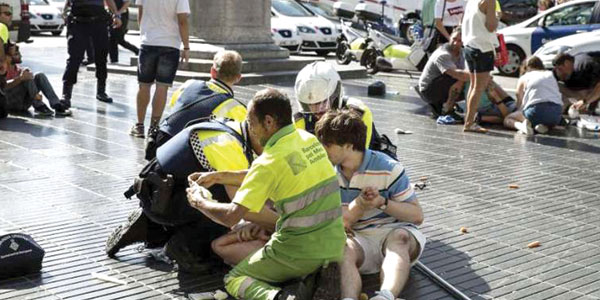
Compiled From News Reports
On Aug. 17 and 18, Spain suffered two terrorist attacks – and several more attacks might have followed if Spanish authorities hadn’t intervened, multiple news sources are reporting.
The first attack was carried out Aug. 17 via a van being driven into a crown in Barcelona. As of Tuesday afternoon (Aug. 22), the latest news reports placed the death toll at 15, counting a casualty from a carjacking-related stabbing following the attack in Barcelona. Various reports have stated that 120-plus people suffered injuries.
Spanish authorities announced Monday (Aug. 21) that the suspected perpetrator of the attack – Moroccan-born Younes Abouyaaquob – had been killed that day by Spanish law enforcement officers during a confrontation in rural Spain. According to multiple news agencies, Abouyaaquob claimed during the confrontation to be wearing a suicide vest; however, it was later determined Abouyaaquob had a phony bomb attached to his vest.
The second attack was carried out via car early on Aug. 18, in Cambrils – a seaside community of about 33,000 residents. One woman reportedly died from the attack and several people were injured.
According to various reports, there were five people in the car. After crashing it, they allegedly wielded knives and other bladed weaponry. Of the five terrorist suspects, three were in their late teens and two were in their early to mid-20s. Multiple reports have confirmed that all five are dead, with four of them killed by a law enforcement officer at the attack scene.
At press time, news agencies were reporting that Abouyaaquob and the five Cambrils attack suspects had been members of a terrorist cell connected with the Islamic State, the terrorist organization claiming responsibility for the Barcelona and Cambrils attacks. Reuters and other media agencies were reporting that imam Abdelbaki Es Satty was suspected of orchestrating the two attacks in Spain.
In a story posted Tuesday afternoon online, Reuters reported that two men suspected of being affiliated with the terrorist cell testified in Spanish High Court that there had been plans to launch additional attacks using explosive devices.
______________________________________________________________________________________
Huelga de terroristas en Barcelona, Cambrils
Los días 17 y 18 de agosto, España sufrió dos ataques terroristas – y varios ataques podrían haber ocurrido si las autoridades españolas no hubieran intervenido, informaron múltiples medios de comunicación.
El primer ataque se llevó a cabo el 17 de agosto mediante una furgoneta que fue manejada en Barcelona. A partir del martes por la tarde (22 de agosto), las últimas noticias colocaron el número de muertos en 15, contando una lesión por una puñalada relacionada con el automóvil tras el ataque en Barcelona. Varios informes han señalado que más de 120 personas sufrieron heridas.
Las autoridades españolas anunciaron el lunes (21 de agosto) que el sospechoso del ataque, Younes Abouyaaquob, de origen marroquí, había sido asesinado ese día por agentes de seguridad españoles durante un enfrentamiento en las zonas rurales de España. Según diversos medios de comunicación, Abouyaaquob afirmó durante la confrontación que llevaba un chaleco suicida. Sin embargo, más tarde se determinó que Abouyaaquob tenía una bomba falsa unida a su chaleco.
El segundo ataque se llevó a cabo con un coche a principios de agosto, en Cambrils – una comunidad costera de unos 33,000 residentes. Según informes, una mujer murió por el ataque y varias personas resultaron heridas.
Según varios informes, había cinco personas en el coche. Después de estrellarlo, supuestamente manejaban con cuchillos y palas. De los cinco sospechosos del ataque terrorista, tres eran adolescentes y dos estaban en los inicios de sus 20’s. Múltiples reportes han confirmado que los cinco están muertos, con cuatro de ellos que fueron asesinados por policías en la escena de ataque.
Al cierre de esta edición, los medios de comunicación informaron que Abouyaaquob y los cinco sospechosos de los ataques Cambrils habían sido miembros de una célula terrorista conectada con el Estado Islámico, la organización terrorista que reclamaba la responsabilidad de los ataques de Barcelona y Cambrils. Reuters y otras agencias de medios informaron que el imam Abdelbaki EsSatty fue sospechoso de orquestar los dos ataques en España.
En un artículo publicado el martes por la tarde en internet, Reuters informó que dos hombres sospechosos de estar afiliados a la célula terrorista testificaron en el Tribunal Supremo de España que tenía planes de lanzar más ataques usando artefactos explosivos.










